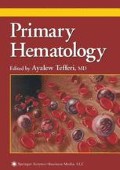Abstract
Because of the eosinophil’s association with unusual disorders, few discoveries on the peripheral blood smear elicit as much trepidation as that of an increased eosinophil count. Despite the ease of eosinophil quantitation afforded by automated leukocyte differential counts, it is important to remember that eosinophils reside mainly in the tissues. In humans, the ratio of bone marrow:blood eosinophils is 3.7–5.1 to 1. In the adult rat, the ratio of tissue:blood eosinophils is about 200–300 to 1. It is here, in the organs themselves, that this cell works both to protect and to damage the host. The eosinophil numbers in the peripheral blood represent an equilibrium among bone marrow production, trafficking in the circulation, and a final destination in tissue, where eosinophil function, apoptosis, and death transpire. The half-life of eosinophils in the circulation is approximately 18 hours, and their total life span is about 6 days.
Access this chapter
Tax calculation will be finalised at checkout
Purchases are for personal use only
Preview
Unable to display preview. Download preview PDF.
Reference
Gleich GJ, Schroeter AL, Marcoux JP, Sachs MI, O’Connell EJ, Kohler PF. Episodic angioedema associated with eosinophilia. N Engl J Med 1984; 310: 1621–1626.
Suggested Reading
Brito-Babapulle F. Clonal eosinophilic disorders and the hypereosinophilic syndrome. Blood Rev 1997; 11: 129–145.
Butterfield JH. Hypereosinophilic syndromes. Established and new treatment options. Biodrugs 1997; 7: 341–355.
Butterfield JH, Leiferman KM, Gleich GJ. Eosinophil-associated diseases, in Samter’ s Immunologic Diseases (Frank MM, Austen KF, Claman HN, Unanue ER, eds.), 5th ed, vol 1. Little, Brown and Company, Boston, 1995, pp. 501–527.
Carrington CB, Addington WW, Goff AM, Madoff IM, Marks A, Schwaber JR, Gaensler EA. Chronic eosinophilic pneumonia. N Engl J Med 1969; 280: 787–798.
Denning DW, Van Wye JE, Lewiston NJ, Stevens DA. Adjunctive therapy of allergic bronchopulmonary aspergillosis with itraconazole. Chest 1991; 100: 813–819.
Frigas E, Loegering DA, Solley GO, Farrow GM, Gleich GJ. Elevated levels of the eosinophil granule major basic protein in the sputum of patients with bronchial asthma. Mayo Clin Proc 1981; 56: 345–353.
Imbeau SA, Nichols D, Flaherty D, Dickie H, Reed C. Relationships between prednisone therapy, disease activity, and the total serum IgE level in allergic bronchopulmonary aspergillosis. JAllergy Clin Immunol 1978; 62: 91–95.
Klein NC, Hargrove RL, Sleisenger MH, Jeffries GH. Eosinophilic gastroenteritis. Medicine (Baltimore) 1970; 49: 299–319.
Nicolas L, Scoles GA. Multiplex polymerase chain reaction for detection of Dirofilaria immitis (Filariidea: Onchocercidae) and Wuchereria bancrofti (Filarioidea: Dipetalonematidae) in their common vector Aedes polynesiensis (Diptera: Culicidae). J Med Entomol 1997; 34: 741–744.
Peters MS, Schroeter AL, Kephart GM, Gleich GJ. Localization of eosinophil granule major basic protein in chronic urticaria. J Invest Dermatol 1983; 81: 39–43.
Sen P, Gil C, Estrellas B, Middleton JR. Corticosteroid-induced asthma: a manifestation of limited hyperinfection syndrome due to Strongyloides stercoralis. South Med J 1995; 88: 923–927.
Silver RM, Heyes MP, Maize JC, Quearry B, Vionnet-Fuasset M, Sternberg EM. Scleroderma, fasciitis, and eosinophilia associated with the ingestion of tryptophan. N Engl J Med 1990; 322: 874–881.
Uhrbrand H. The number of circulating eosinophils: normal figures and spontaneous variations. Acta Med Scand 1992; 160: 99–104.
van Haelst Pisani C, Kovach JS, Kita H, Leiferman KM, Gleich GJ, Silver JE, Dennin R, Abrams JS. Administration of interleukin-2 (IL-2) results in increased plasma concentrations of IL-5 and eosinophilia in patients with cancer. Blood 1991; 78: 1538–1544.
Weller PF, Bubley GJ. The idiopathic hypereosinophilic syndrome. Blood 1994; 83: 2759–2779.
Editor information
Editors and Affiliations
Rights and permissions
Copyright information
© 2001 Springer Science+Business Media New York
About this chapter
Cite this chapter
Butterfield, J.H. (2001). The Eosinophil and Eosinophilia. In: Tefferi, A. (eds) Primary Hematology. Humana Press, Totowa, NJ. https://doi.org/10.1007/978-1-59259-228-9_12
Download citation
DOI: https://doi.org/10.1007/978-1-59259-228-9_12
Publisher Name: Humana Press, Totowa, NJ
Print ISBN: 978-1-61737-122-6
Online ISBN: 978-1-59259-228-9
eBook Packages: Springer Book Archive

